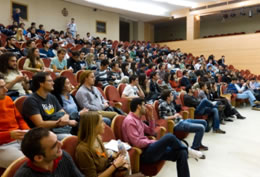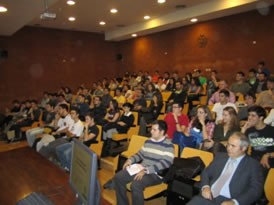
“November Nuclear” at the Universidad Politécnica de Madrid: A Basic Course on Nuclear Science and Technology and a Seminar on Nuclear Fusion
ABSTRACT
Last November, as part of the activities of the Nuclear JJNN November, a Basic Course on Nuclear Science and Technology and a Nuclear Fusion Seminar took place in the School of Industrial Engineers of the Polytechnic University of Madrid (UPM).
Attendance at the course and seminar was impressive - about 200 students listened attentively and with interest to the speakers that delivered the Basic Course. More than 70 people took part in the Fusion Seminar.
BASIC COURSE ON NUCLEAR SCIENCE AND TECHNOLOGY
The Basic Course took place on November 25. It began at 15:30 and attendees had the honor of listening to an opening address from Eduardo Gallego, Director of the Department of Nuclear Engineering, who shared the microphone with the two course co-ordinators, Raquel Ochoa (JJNN Vice Chairman) and Gonzalo Jimenez (a member of the JJNN Board). The speakers gave brief presentations of between 10 and 20 minutes, during which time they highlighted each component of the basic principles of nuclear technology.

Fig. 1 Participants in the Basic Course
The course began with a presentation by Manuel Fernandez-Ordonez outlining the basics of nuclear physics. Luis Yagüe (JJNN’s Chairman) then summarised the various components that make up a light water reactor in a nuclear power plant. Patricia Rubio presented the complete fuel cycle from uranium mining to the production of fission energy, providing further information and giving special emphasis to one of the most important of all the components, the nuclear fuel.
Miguel Sanchez addressed one of the most topical subjects today, nuclear safety. In particular, he listed the main concepts of nuclear safety. In the final presentation before the break, Alfonso Barbas addressed issues related to radiation protection. Then the session concluded with questions and answers.

Fig. 2 Rear view of the auditorium for the Basic Course
After the break, Gonzalo Jimenez addressed another key topic - to quote his own words, "another great workhorse of the nuclear energy debate" - nuclear waste. An exhibition during the course was accompanied by two separate video demonstrations, all of which stimulated and encouraged the attendees to take part. Then Raquel Ochoa described the characteristics of the next generation of reactors.
Leaving aside what up until now had been the sole focus, namely nuclear energy as a source of generating electricity, Alfonso Vinuesa cited some of the other important applications of nuclear technology. Almudena Diaz then concluded by talking about climate change and sustainable development.
Before the course was finished there was another interesting round of questions. Finally, the presentation of diplomas took place and the event officially concluded.
The highlight of the course, besides the great reaction it received from attendees, was the active participation of all those present in the two rounds of questions and answers that followed the presentations.
SEMINAR ON NUCLEAR FUSION
The other major activity that took place at the November Nuclear, the Nuclear Fusion Seminar, took place on 21, 23, 28 and 30 November. Dr. Manuel Perlado, Director of the Institute of Nuclear Fusion and Professor at the Department of Nuclear Engineering of the UPM, opened the seminar with a presentation on current research in nuclear fusion in Spain. He was accompanied by the coordinators of the seminar and members of the Board of Young Nuclear Generation, Gonzalo Jimenez and Rachel Ochoa.
The seminar was organised over a period of four days: the first day provided an historical introduction to the subject, the two following sessions focused on the two main technologies on the debating agenda, namely inertial confinement fusion and magnetic confinement fusion.
The final session concluded with an overview of ongoing major international projects, with special reference given to the challenges and difficulties of each technology.
The first speaker, Alberto Fraile, explained the beginning of fusion research and basic principles of fusion technology, including references to its non-civilian usages. The presentation was lively, with many videos and anecdotes and a high level of public participation.
The next presentation was given by Manuel Cotelo, who stated with clarity the theoretical principles of inertial confinement fusion technology and outlined the ongoing projects and future prospects of this technology.

Fig. 3 Attendees at the Nuclear Fusion Seminar
Antonio Rivera introduced to participants the complex technology of magnetic confinement fusion. He spoke about its strengths and challenges and presented in depth the theoretical concepts that underpin it.
Finally, in the last session, Jesus Alvarez gave a broad overview of past projects, present initiatives and future prospects for both technologies, highlighting the projects and courses in which there is Spanish participation.
The closing session of the seminar was chaired by Dr. Emilio Mínguez, UPM Vice-Rector and member of the Board of the Spanish Nuclear Society (SNE) and Luis Yague, President of the Spanish Young Nuclear.
This inaugural Nuclear Fusion Seminar at the Institute for Fusion Research of UPM (ETSIIIM) was well received and aroused considerable interest. This was important as it was necessary to ensure that all those who had enrolled had access to the seminar – and the auditorium was virtually full capacity for each session!
By Gonzalo Jiménez and Raquel Ochoa
Universidad Politécnica de Madrid (UPM)
|

